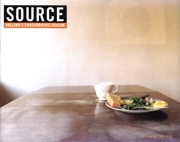For She Loved Much
'For She Loved Much', photographs by Maoliosa Boyle was shown at Clotworthy House 6th - 30th October 1998
Review by Siún Hanrahan
Issue 17 Winter 1998
View Contents ▸
Maoliosa Boyle's exhibition 'For She Loved Much,' consists of a series of photographs taken within Derry's recently derelict Magdalene Laundry. This and a host of similar institutions throughout England and Ireland housed unmarried mothers and 'unmanageable' women. As the name of these establishments indicates, the women washed clothes during their confinement. Boyle suggests that this served as a kind of 'industrial therapy' or penance, reminiscent of that of Mary Magdalene herself perhaps. The seven photographs making up this exhibition seek to address the plight of these women by focusing on the spaces they once occupied.
As conveyed through Boyle's austere interiors, the space allotted the women was punitive. Their pregnancies were unwanted - occurring outside of marriage they were a breach of paternal authority as embodied in 'the family,' instead signifying maternal power. The women thus embodied a threat to the existing moral and legal order. The laundries contained their disruptive force. Original in colour
Original in colour
One of the images features a lonely chair sitting in the corner of an unfinished, windowless room. The only light is that which streams in through an open door facing the viewer. Although bathed in light the placement of the chair renders it invisible from the other room. Its position speaks to that of the women themselves - isolated and safely out of the sight of a society that didn't want to know. Beyond the door the upper-wall of the work-room is made of glass. If, as Abercrombie suggests, the power of an interior space lies in the fact that it surrounds us so that we are its contents, then the impact of that space is not limited to its visual appearance but includes 'how we experience being the content of that space.' Whatever the practicalities of the glass wall, to have occupied this space was to be perpetually self-conscious of being watched. This was an isolated and supervised space. Original in colour
Original in colour
Thus the laundry was experienced as punitive despite having been set up to shelter women cast out by society. This ambiguity concerning the laundry's role is reflected in two of Boyle's images. In one image, what looks like an antechamber to the laundry - its public face - is decently appointed but not luxurious. Perhaps this reflects the equivocation of a society that didn't consider the women criminals but didn't want socially disruptive behaviour rewarded. While, in another image, although the cruciform light pattern guiding you down a long corridor is reminiscent of a passage back to society, the journey promises to be cold and exposed and the chances of acceptance seem remote. Original in colour
Original in colour
Writing about her experience of exile, the Iranian artist Cohreh Feyzdjou suggested that 'When you feel you don't belong to anything, then you try to make your own universe. It's a positive thing.' Whether or not this option is available in Boyle's Magdalene Laundry is an open question. The fragility of any such re-creative enterprise is indicated by the image of a closed 1960s record player on a rickety stand, beside which a wheelchair sits facing the wall. Whatever snatches of fun and 'life' were created here seem to have been easily toppled, and reminders of society's obstinate refusal of support were omnipresent. Original in colour
Original in colour
A set of three images of a long narrow corridor punctuated by open doors and a glass top on either wall is equally ambivalent about the possibility of creating an alternative 'universe.' On the one hand, the rooms seem to be bedrooms, in which case the glass in the wall must again remove any possibility of true privacy so that the creative potential of 'a room of her own' is denied. Furthermore, the changing light conditions of the corridor across the three images (morning to evening) implies long, monotonous days. On the other hand, the triptych inscribes cyclical time within the Magdalene Laundry. This conception of time is traditionally linked to female subjectivity (through its retaining of ideas of repetition and biological rhythms) so that a fundamentally matriarchal conception of time is shown as persisting against the odds and in stubborn opposition to the linear time of a patriarchal society. Overall, however, it is Boyle's sense of the women's 'loneliness, emptiness and loss' that dominates.
There are striking parallels between Boyle's work and Andrew Grannell's photographic series 'Vanishing Points' (Source 4:1). In both cases the empty interiors of institutions that contained society's disgraced 'other' are used to document the huge suffering occasioned by this rejection. The difficulty addressed by both artists is how do we re-member 'a forgotten and invisible minority with no voice and no presence.'
Boyle's photographs are quiet and take time to unfold but yield a remarkably rich picture of the punishment inflicted upon those who embody a vulnerability and difference that society wishes to deny in itself. The quietness of the show may be attributed in part to the relatively small scale of the photographs (20 x 30 inches). Increasing their size might give the work a more forceful impact. But then, a forceful presence was precisely what the women lacked.
Other articles by Siún Hanrahan:
Other articles on photography from the 'Institutional' category ▸






